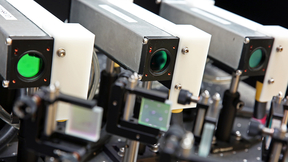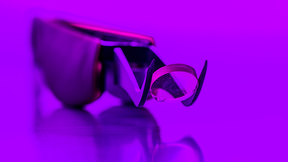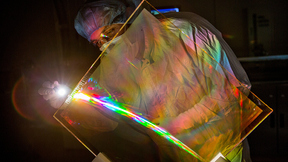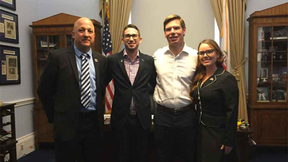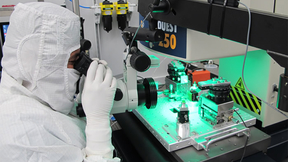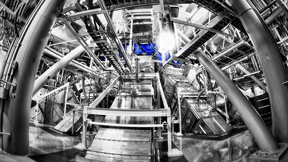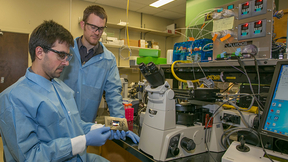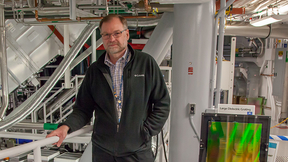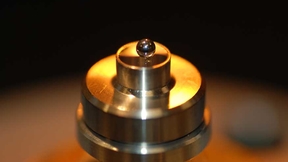Back
Lasers and Optical S&T
Optical Society of America honors Craig Siders
Lawrence Livermore National Laboratory (LLNL) physicist Craig Siders has been named a senior member of the Optical Society of America (OSA), an international society for optics and photonics scientists, engineers, educators and business leaders. Senior membership status recognizes members with more than 10 years of significant experience and professional accomplishments or…
NIF technology could revolutionize 3D printing
A technology originally developed to smooth out and pattern high-powered laser beams for the National Ignition Facility (NIF) can be used to 3D print metal objects faster than ever before, according to a new study by Lawrence Livermore researchers. A team of Lab scientists report the findings in the latest issue of Optics Express, published online on May 15. This new…
Lab breakthrough in 3D printing of glass
Lawrence Livermore National Laboratory scientists and academic collaborators have demonstrated the synthesis of transparent glass through 3D printing, a development that could ultimately lead to altering the design and structure of lasers and other devices that incorporate optics. A team of LLNL researchers, along with scientists from the University of Minnesota and…
Crash-proof virtual flying through NIF
In apparent defiance of the laws of physics, LLNL design engineer Paul Bloom leads flying tours through the National Ignition Facility from only three feet off the ground. As creator of the NIF virtual reality (VR) program, Bloom routinely allows engineers, scientists and technicians to soar through the facility by plugging his NIF tourists into special 3D Model…
Rad to the bone: Meet NIF's rad control technicians
It is 6:30 a.m. when Myrna Gutierrez and Judy Zarco suit up inside the National Ignition Facility (NIF) to begin their 13-hour shift. As radiation control technicians (RCTs), they will maintain the safety of a 10-story building the size of three football fields housing the world’s largest, most energetic laser. It is not an average workplace, and the stakes are high when…
A new way to examine space, bugs and bones
A novel way to harness lasers and plasmas may give researchers new ways to explore outer space and to examine bugs, tumors and bones back on planet Earth. Lawrence Livermore National Laboratory (LLNL) physicist Félicie Albert led an international team pursuing this new regime in laser research, which was described in a Physical Review Letters (PRL) paper published online…
Lab scientists develop next-generation NIF optics to boost energy and limit damage
A new anti-reflective coating and a novel chemical process for laser optics, developed by Lawrence Livermore National Laboratory (LLNL) researchers, represents an important breakthrough in its effort to boost the energy of the National Ignition Facility’s (NIF) 192 giant lasers, and cut the cost of repairing or replacing damaged optics vital to its operation. The coating…
Engineer wins scholarship for women veterans
U.S. Marine veteran Destiny Goddu has spent her whole life working with machines. As a young girl growing up in Livermore, she helped her father, a mechanic, disassemble and rebuild car engines and tinkered with auto parts in the family garage. After joining the Marines, she worked on missile guidance systems, and as a Lab employee, hired part-time through the award…
The softer side of NIF hohlraums
Considering that nothing precious comes from an online retailer without protective padding, could precision laser targets also benefit from similar high-tech swaddling? So far the answer is yes, for a group of scientists developing new target technologies for NIF that are intended to neutralize what they believe is one of the bigger challenges to achieving ignition. The…
National Ignition Facility's dual-purpose positioner is proving its worth
While multitasking may be easy for some people (and perhaps hard for others), it can be a particular challenge for the highly specialized equipment used to carry out experiments on the National Ignition Facility (NIF). But TanDM, NIF’s new Target and Diagnostic Manipulator, is designed to do just that. To date, it is proving itself more than up to the job of performing as…
Fund aids commercialization efforts
For three Lab engineers, a Lawrence Livermore National Laboratory (LLNL) commercialization fund has proven to be an oasis of assistance as they have sought to cross the legendary technology "valley of death."In technology transfer circles, there is a phase -- between when a technology is promising and when it moves forward into commercialization -- known as the "valley of…
LLNL meets key milestone for delivery of world's highest average power petawatt laser system
The High-Repetition-Rate Advanced Petawatt Laser System (HAPLS), being developed at Lawrence Livermore National Laboratory (LLNL), recently completed a significant milestone: demonstration of continuous operation of an all diode-pumped, high-energy femtosecond petawatt laser system. With completion of this milestone, the system is ready for delivery and integration at the…
Recreating conditions inside stars in the laboratory with compact lasers
Using compact lasers, a team including Lawrence Livermore National Laboratory (LLNL) scientists has created pressures more than a billion atmospheres, equivalent to the pressure in the center of a star.These conditions of extreme pressure and energy density have previously been created in the laboratory only with the world's largest lasers, which are the size of stadiums…
Fusion Power Associates award for Joe Kilkenny
The Fusion Power Associates (FPA) Board of Directors has selected NIF Scientific Diagnostic Leader Joe Kilkenny to receive a 2016 Leadership Award. The award was presented at the FPA’s 37th Annual Meeting and Symposium on “Fusion Power: An International Venture,” held recently in Washington, D.C.Kilkenny was cited for “the leadership provided for inertial confinement…
Chris Barty named IEEE Fellow
Chris Barty, chief technology officer in Lawrence Livermore National Laboratory’s (LLNL) NIF & Photon Science Directorate, has been named a 2017 fellow of the Institute of Electrical and Electronics Engineers (IEEE) for his contributions to ultrahigh-intensity lasers and the advancement of X-ray and gamma-ray science. The IEEE grade of fellow is conferred by the IEEE…
Researchers develop new amplifier that could double the capacity of fiber-optic cables
More than 3.4 billion people are connected to the Internet, placing ever-increasing demand on the telecom industry to provide bigger, better and faster bandwidth to users. Lawrence Livermore National Laboratory (LLNL) researchers have taken an important step in addressing that need by developing a new type of optical fiber amplifier that could potentially double the…
Ibo Matthews elected fellow of Optical Society
Lawrence Livermore National Laboratory physicist Manyalibo (Ibo) Matthews has been elected as a fellow of the Optical Society (OSA). He was recognized by OSA for his "outstanding contributions and sustained leadership in the field of high-power laser-induced damage science, laser-material interactions and processing and vibrational spectroscopy-based materials…
LLNL wins three R&D 100 awards
Lawrence Livermore National Laboratory researchers have garnered three awards among the top 100 industrial inventions worldwide for 2016. The trade journal R&D Magazine announced the winners of its annual awards, sometimes called the "Oscars of invention," Thursday at the Gaylord Convention Center in Washington, D.C. With this year’s results, the Laboratory has now…
Scientists explore use of 3D printing to speed up target production for testing material strength
Advanced 3D printing promises to redefine manufacturing in critical industries such as aerospace, transportation and defense, and now, Lawrence Livermore National Laboratory is exploring the use of 3D printing to achieve unprecedented flexibility in producing "on-demand" targets for testing how materials behave under extreme conditions. Through an additive manufacturing…
Putting one foot in front of the other
In just under the time it would take to fly around the world two times -- 85 hours -- Justin Galbraith ran and hiked more than 200 miles to cross the finish line of the Tahoe 200 Endurance Run. Fighting blisters on every toe, temperatures ranging from the 40s to the 80s and sleeping only three hours, Galbraith completed the course that follows the Tahoe Rim Trail and has…



